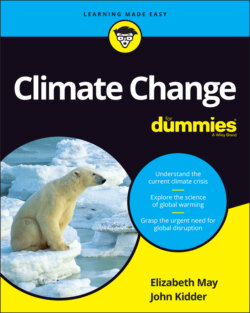Читать книгу Climate Change For Dummies - Elizabeth May - Страница 20
The United States and Canada
ОглавлениеIn the United States and Canada, average temperatures have been rising because of climate change. As a result, the growing season has lengthened; trees have been sucking in more carbon, and for a while, farms were more productive. The recent years have had far more severe wet years followed by extreme drought. The 2021 drought had negative and long-term impact on wheat, corn, and other crops, according to Forbes.
Many plants and animals are spreading farther north to adapt to climate changes, affecting the existing species in the areas to which they’re moving. Increased temperatures have already been a factor in more forest fires and wildfires and damage by forest insects, such as the pine beetle epidemic in the interior of British Columbia, Canada. (See Chapter 8 for more information about how global warming will affect animals and forests.)
Scientists project that the United States and Canada will feel the effects of climate change more adversely in the coming years. Here are some of the problems, anticipated to only get worse if civilization doesn’t dramatically reduce GHG emissions:
Droughts and heat domes: Rising temperatures are increasing droughts in areas that are already arid, putting even larger pressure on scarce water sources in areas such as the U.S. Southwest. In Canada, 600 people died from extreme heat in 2021 as a heat dome (happens when the atmosphere traps hot ocean air) formed over the west and drove temperatures to record levels. Some areas of British Columbia experienced temperatures of 122 degrees Fahrenheit (50 degrees Celsius).
Evaporating lakes: The cities in the great heartland of the Great Lakes Basin will face retreating shorelines when the water levels of the Great Lakes drop because of increased evaporation. Lower water levels will also affect ship and barge traffic along the Mississippi, St. Lawrence, and other major rivers.
Floods: Warmer air contains more moisture, and North Americans are already experiencing more sudden deluge events, causing washed out roads and bridges, and flooded basements and even Manhattan’s subways. In British Columbia in 2021, a form of rainstorm so extreme it’s called an atmospheric river caused massive flooding. The estimated damage to farms and transportation infrastructure was about $5.9 billion US, $7.5 billion Canadian. Bridges and other sections of roads and highways were washed away, isolating coastal areas from the rest of Canada for weeks.
Major storms: Warming oceans increase the risk of extreme weather that will plague coastal cities. Think of Hurricane Katrina, arguably the most devastating weather event ever to hit a North American city, as a precursor of storms like Superstorm Sandy. Katrina was whipped into a hurricane with a massive punch from the super-heated waters of the Gulf of Mexico in 2005. In 2021 a devastating series of tornadoes, way outside the “normal” tornado season, clobbered the southern and central United States, killing almost 100 people and causing millions in damage. Not all extreme weather events are hurricanes. Global warming is expected to increase ice storms in some areas and thunderstorms in others.
Melting glaciers: Glaciers from the Rockies to Greenland, are in rapid retreat, according to the National Snow and Ice Data Center. Glacier National Park could someday be a park where the only glacier is in the name. When glaciers go, so does the spring recharge that flows down into the valleys, increasing the pressure on the remaining water supplies. People who depend on drinking water from rivers or lakes that are fed by mountain glaciers will also be vulnerable.
Rising sea levels: Water expands when it gets warmer, so as global average temperatures rise, warmer air warms the ocean. Oceans are expanding, and sea levels are rising around the world, threatening coastal cities — many of which are in the United States and Canada. This sea level rise will be far more devastating if ice sheets in Greenland and Antarctica collapse.
Changes across northern Canada and Alaska are more profound than in the south. We discuss these impacts in the section “Polar regions,” later in this chapter.
On average, North Americans have many resources, in comparison to developing regions of the world, to help them adapt to climate change. The Intergovernmental Panel on Climate Change (IPCC) says Canada and the United States can take steps to avoid many of the costs of climate change, to better absorb the effects, and to avoid the loss of human lives. For example, North America could establish better storm warning systems and community support to make sure that poor people in inner cities have some hope of relief during more frequent killer heat waves. (See Chapter 10 for more information about what governments can do to help their countries adapt to the effects of climate change.)
